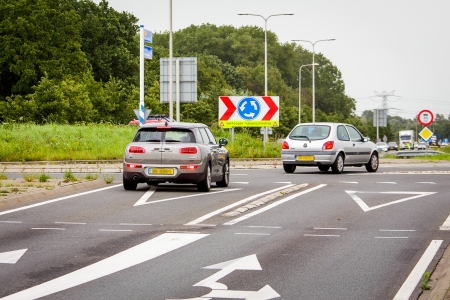For cyclists, roundabouts are generally much safer than other types of intersection. In the Netherlands, from the 1980s onwards, a lot of intersections were converted to roundabouts, with or without separate bicycle facilities. The effects on (light) moped rider and cyclist safety were also researched at that time. The research showed that conversion of an ordinary intersection to a roundabout resulted in a 60% decrease of casualties among (light) moped riders and cyclists, after correction for the general downward trend in casualty numbers [12][i]. More recent research in Belgium and Denmark shows that, in those countries, the conversion from intersections to roundabouts is less favourable to the number of (serious) injury crashes among cyclists [28] [29]. These studies are, however, hard to compare to the Dutch studies. For example, the number of cyclists, in Belgium in particular, is lower than in the Netherlands, and speed at Danish roundabouts is less restricted by road design than it is at Dutch roundabouts. Thus, it is unlikely that Belgian and Danish results also apply to the Dutch situation.
In the Netherlands, after the conversion of intersections to roundabouts, increases in cyclist safety differ between roundabouts. The size of the crash reduction depends on the bicycle facility chosen. Table 6 shows the effects on the number of (light) moped and bicycle crashes after the conversion. The table compares bicycle facilities in the old situation (intersection) and the new situation (roundabout). The table shows that implementing bicycle tracks at roundabouts decreases the number of (light) moped and bicycle crashes most (89-100% fewer crashes than at the old intersections). In addition, removing bicycle tracks from the old situation (intersection) has the least effect (13-39% fewer crashes at the roundabout) [30]. Moreover, at roundabouts, fewer blind spot crashes occur than at intersections. Only 11% of all blind spot crashes in 2002-2006 occurred at a roundabout [25].
|
Bicycle facility at intersection (before) |
Bicycle facility at roundabout (after) |
% reduction of moped and bicycle crashes |
Number of locations studied |
|
Intersection without bicycle facility |
Roundabout without bicycle facility |
50% |
15 |
|
Roundabout with bicycle lane |
54% |
35 |
|
|
Roundabout with bicycle track |
100% |
8 |
|
|
Intersection with bicycle lane |
Roundabout with bicycle lane |
31% |
20 |
|
Intersection with bicycle track |
Roundabout without bicycle facility |
13% |
3 |
|
Roundabout with bicycle lane |
39% |
48 |
|
|
Roundabout with bicycle track |
89% |
49 |
|
|
Total |
|
55% |
178 |
Table 6. Effect of converting an intersection to a roundabout on number of moped and bicycle crashes [30].
Cross-comparing roundabouts for the number of cyclist fatalities, roundabouts with bicycle tracks prove to be safer than roundabouts without bicycle facilities and roundabouts with bicycle lanes, and roundabouts without bicycle facilities have fewer cyclist fatalities than roundabouts with bicycle lanes [12] [31] [32]. These results are also apparent from foreign studies [28] [29] [33].
Based on a recent publication [10] in which registered traffic casualties at roundabouts were analysed, it has been claimed that roundabouts are less safe for cyclists than previously believed [34]. Additionally, in a recent masters thesis [35] comparing the crash risk for cyclists on 7 roundabouts in Haarlem to the risks on the city’s other intersection types, the bicycle crash risk was unexpectedly found to be highest for roundabouts. Based on these two studies, however, it is too early to conclude that roundabouts are less safe for cyclists. As discussed in the masters thesis, the small sample size of roundabouts is not sufficiently representative for all roundabouts in the Netherlands. In the other study analysing traffic casualties on all roundabouts, no correction was made for cyclist volumes. At intersections with more cyclists there are, with a constant crash risk, more bicycle crashes. A big advantage of before-and-after studies, such as in Table 6, is that they can correct for these possible differences.
For more information about cyclist safety, see SWOV fact sheet Cyclist.
[i] In the reference cited, no distinction was made between moped riders, light moped riders and cyclists, because they all used the bicycle track at the time of the study. That is why their data are aggregated. This also goes for table 6 and the explanation of the table.
